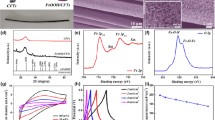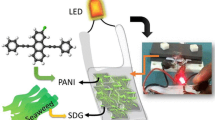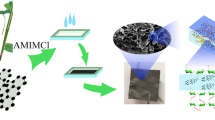Abstract
With the development of renewable energy technologies, the recovery and utilization of low-grade energy based on hydroelectric effect have drawn much attention owing to its environmental friendliness. Herein, a novel hydroelectric generator utilizing sodium alginate-graphene oxide (SA-GO) fibers is proposed, which is ecofriendly and low-cost. These fibers with a length of 5 cm and a diameter of 0.15 mm can generate an open circuit voltage (Voc) of approximately 0.25 V and a short circuit current (Isc) of 4 µA. By connecting SA-GO fibers in either series or parallel, this combination can power some electronic devices. Furthermore, these fibers enable the recovery of low-grade energy from the atmosphere or around the human body. Both experimental and theoretical analysis confirm that the directional flow of protons driven by water molecules is the main mechanism for power generation of SA-GO fibers. This study not only presents a simple energy transformation method that is expected to be applied to our daily life, but also provides a novel idea for the design of humidity electricity-generation devices.
Similar content being viewed by others
References
Kılkış Ş, Krajačić G, Duić N, et al. Research frontiers in sustainable development of energy, water and environment systems in a time of climate crisis. Energy Conversion and Management, 2019, 199: 111938
Zhou Q, Gong F, Xie Y L, et al. A general strategy for designing metal-free catalysts for highly-efficient nitric oxide reduction to ammonia. Fuel, 2022, 310: 122442
Gong F, Wang W B, Li H, et al. Solid waste and graphite derived solar steam generator for highly-efficient and cost-effective water purification. Applied Energy, 2020, 261: 114410
Kempton W, Pimenta F M, Veron D E, et al. Electric power from offshore wind via synoptic-scale interconnection. Proceedings of the National Academy of Sciences of the United States of America, 2010, 107(16): 7240–7245
Gong F, Li H, Wang W B, et al. Scalable, eco-friendly and ultrafast solar steam generators based on one-step melamine-derived carbon sponges toward water purification. Nano Energy, 2019, 58: 322–330
Moriarty P. Global nuclear energy: An uncertain future. AIMS Energy, 2021, 9(5): 1027–1042
Wang Z, Tan L, Pan X M, et al. Self-powered viscosity and pressure sensing in microfluidic systems based on the piezoelectric energy harvesting of flowing droplets. ACS Applied Materials & Interfaces, 2017, 9(34): 28586–28595
Cai M J, Yang Z S, Cao J Y, et al. Recent advances in human motion excited energy harvesting systems for wearables. Energy Technology, 2020, 8(10): 2000533
Fang L, Zheng Q W, Hou W C, et al. A self-powered vibration sensor based on the coupling of triboelectric nanogenerator and electromagnetic generator. Nano Energy, 2022, 97: 107164
Zhou L M, Liu Y Y, Liu S L, et al. For more and purer hydrogen-the progress and challenges in water as shift reaction. Journal of Energy Chemistry, 2023, 83: 363–396
Wang S J, Gong F, Zhou Q, et al. Transition metal enhanced chromium nitride as composite nitrogen carrier for sustainable chemical looping ammonia synthesis. Applied Catalysis B: Environmental, 2023, 339: 123134
Yang C R, Ko C T, Chang S F, et al. Study on fabric-based triboelectric nanogenerator using graphene oxide/porous PDMS as a compound friction layer. Nano Energy, 2022, 92: 106791
Benadda B, Beldjilali B, Mankouri A, et al. Secure IoT solution for wearable health care applications, case study Electric Imp development platform. International Journal of Communication Systems, 2018, 31(5): e3499
Nelson E C, Verhagen T, Vollenbroek-Hutten M, et al. Is wearable technology becoming part of us? Developing and validating a measurement scale for wearable technology embodiment. HJMIR mealth and uHealth, 2019, 7(8): e12771
Dolez P I. Energy harvesting materials and structures for smart textile applications: Recent progress and path forward. Sensors, 2021, 21(18): 6297
Jiang G Q, Dong T, Guo Z K. Nonlinear dynamics of an unsymmetric cross-ply square composite laminated plate for vibration energy harvesting. Symmetry, 2021, 13(7): 1261
Song J W, Sun G H, Zeng X, et al. Piezoelectric energy harvester with double cantilever beam undergoing coupled bending-torsion vibrations by width-splitting method. Scientific Reports, 2022, 12(1): 583
Li Z, Yuan S M, Ma J, et al. Cutting force and specific energy for rotary ultrasonic drilling based on kinematics analysis of vibration effectiveness. Chinese Journal of Aeronautics, 2022, 35(1): 376–387
Zhou Q, Gong F, Xie Y L, et al. 1 + 1 > 2: Learning from the interfacial modulation on single-atom electrocatalysts to design dual-atom electrocatalysts for dinitrogen reduction. ScienceDirect, 2023, 8(6): 1753–1763
Yadav P, Sahay K, Srivastava M, et al. Emerging trends in self-healable nanomaterials for triboelectric nanogenerators: A comprehensive review and roadmap. Frontiers in Energy, 2023, 17(6): 727–750
Gao H Q, Hu M G, Ding J F, et al. Investigation of contact electrification between 2D MXenes and MoS2 through density functional theory and triboelectric probes. Advanced Functional Materials, 2023, 33(15): 2213410
Sun Z Y, Wen X, Wang L M, et al. Emerging design principles, materials, and applications for moisture-enabled electric generation. eScience, 2022, 2: 32–46
Luo Z L, Liu C H, Fan S S. A moisture induced self-charging device for energy harvesting and storage. Nano Energy, 2019, 60: 371–376
Liang Y, Zhao F, Cheng Z H, et al. Electric power generation via asymmetric moisturizing of graphene oxide for flexible, printable and portable electronics. Energy & Environmental Science, 2018, 11(7): 1730–1735
Zhang J, Zhan K, Zhang S S, et al. Discontinuous streaming potential via liquid gate. eScience, 2022, 2: 615–622
Bai J X, Huang Y X, Wang H Y, et al. Sunlight-coordinated highperformance moisture power in natural conditions. Advanced Materials, 2022, 34(10): 2103897
Ji L, Zheng K, Zheng L, et al. Direct transition of potential of water droplets to electric energy using aligned single-walled carbon nanotubes. Chinese Physics B, 2010, 19(6): 066101
Yang C, Huang Y X, Cheng H H, et al. Rollable, stretchable, and reconfigurable graphene hygroelectric generators. Advanced Materials, 2019, 31(2): 1805705
Zhang Z H, Li X M, Yin J, et al. Emerging hydrovoltaic technology. Nature Nanotechnology, 2018, 13(12): 1109–1119
Guan W X, Guo Y H, Yu G H. Carbon materials for solar water evaporation and desalination. Small, 2021, 17(48): 2007176
Zhang P X, Liu Y Y, Liu S L, et al. Precise design and modification engineering of single-atom catalytic materials for oxygen reduction. Small, 2024, 20(4): 2305782
Zhang H H, Liu Y Y, Wei H J, et al. Atomic-bridge structure in B-Co-P dual-active sites on boron nitride nanosheets for catalytic hydrogen generation. Applied Catalysis B: Environmental, 2022, 314: 121495
Xu T, Ding X T, Huang Y X, et al. An efficient polymer moist-electric generator. Energy & Environmental Science, 2019, 12(3): 972–978
Xue G B, Xu Y, Ding T P, et al. Water-evaporation-induced electricity with nanostructured carbon materials. Nature Nanotechnology, 2017, 12(4): 317–321
Li J, Liu K, Xue G B, et al. Electricity generation from water droplets via capillary infiltrating. Nano Energy, 2018, 48: 211–216
Gong F, Li H, Zhou Q, et al. Agricultural waste-derived moisture-absorber for all-weather atmospheric water collection and electricity generation. Nano Energy, 2020, 74: 104922
Liang Y, Zhao F, Cheng Z H, et al. Self-powered wearable graphene fiber for information expression. Nano Energy, 2017, 32: 329–335
Li J H, Xia B L, Xiao X, et al. Stretchable thermoelectric fibers with three-dimensional interconnected porous network for low-grade body heat energy harvesting. ACS Nano, 2023, 17(19): 19232–19241
Cho H, Kim S, Liang H, et al. Electric-potential-induced uniformity in graphene oxide deposition on porous alumina substrates. Ceramics International, 2020, 46(10): 14828–14839
Han Z, Fina A. Thermal conductivity of carbon nanotubes and their polymer nanocomposites: A review. Progress in Polymer Science, 2011, 36(7): 914–944
Yan H P, Liu Z, Qi R H. A review of humidity gradient-based power generator: Devices, materials and mechanisms. Nano Energy, 2022, 101: 107591
Wang K Q, Xu W H, Zhang X, et al. Bio-inspired water-driven electricity generators: From fundamental mechanisms to practical applications. Nano Research Energy, 2023, 2: e9120042
Zhang P X, Sun K, Liu Y Y, et al. Improving bifunctional catalytic activity of biochar via in-situ growth of nickel–iron hydroxide as cathodic catalyst for zinc-air batteries. Biochar, 2023, 5(1): 60
Zhang P X, Liu Y Y, Wang S L, et al. Wood-derived monolithic catalysts with the ability of activating water molecules for oxygen electrocatalysis. Small, 2022, 18(34): 2202725
Hassan S H, Velayutham T S, Chen Y W, et al. TEMPO-oxidized nanocellulose films derived from coconut residues: Physicochemical, mechanical and electrical properties. International Journal of Biological Macromolecules, 2021, 180: 392–402
Li M J, Zong L, Yang W Q, et al. Biological nanofibrous generator for electricity harvest from moist air flow. Advanced Functional Materials, 2019, 29(32): 1901798
Shakeri F, Ariaeenejad S, Ghollasi M, et al. Synthesis of two novel bio-based hydrogels using sodium alginate and chitosan and their proficiency in physical immobilization of enzymes. Scientific Reports, 2022, 12(1): 2072
Li Y Q, Zhang H, Fan M Z, et al. A robust salt-tolerant superoleophobic alginate/graphene oxide aerogel for efficient oil/water separation in marine environments. Scientific Reports, 2017, 7(1): 46379
Bae J, Yun T G, Suh B L, et al. Self-operating transpiration-driven electrokinetic power generator with an artificial hydrological cycle. Energy & Environmental Science, 2020, 13(2): 527–534
Zhang R, Qu M J, Wang H, et al. Moist-electric films based on asymmetric distribution of sodium alginate oxygen-containing functional groups. Reactive & Functional Polymers, 2022, 181: 105421
Chen Z D, Song J, Xia Y M, et al. High strength and strain alginate fibers by a novel wheel spinning technique for knitting stretchable and biocompatible wound-care materials. Materials Science and Engineering C, 2021, 127: 112204
Gong F, Li H, Huang J G, et al. Low-grade energy harvesting from dispersed exhaust steam for power generation using a soft biomimetic actuator. Nano Energy, 2022, 91: 106677
Lv Y L, Gong F, Li H, et al. A flexible electrokinetic power generator derived from paper and ink for wearable electronics. Applied Energy, 2020, 279: 115764
Abbasi H R, Karimian S M H. Water mass flow rate in a finite SWCNT under electric charge: A molecular dynamic simulation. Journal of Molecular Liquids, 2016, 224: 165–170
Xu Y F, Chen P N, Peng H S. Generating electricity from water through carbon nanomaterials. Chemistry, 2018, 24(24): 6287–6294
Zhao F, Cheng H H, Zhang Z P, et al. Direct power generation from a graphene oxide film under moisture. Advanced Materials, 2015, 27(29): 4351–4357
Daripa S, Khawas K, Behere R P, et al. Efficient moisture-induced energy harvesting from water-soluble conjugated block copolymer-functionalized reduced graphene oxide. ACS Omega, 2021, 6(11): 7257–7265
Li Q J, Zhou M, Yang Q F, et al. Flexible carbon dots composite paper for electricity generation from water vapor absorption. Journal of Materials Chemistry. A, Materials for Energy and Sustainability, 2018, 6(23): 10639–10643
Chen N, Liu Q, Liu C, et al. MEG actualized by high-valent metal carrier transport. Nano Energy, 2019, 65: 104047
Gao X, Xu T, Shao C X, et al. Electric power generation using paper materials. Journal of Materials Chemistry. A, Materials for Energy and Sustainability, 2019, 7(36): 20574–20578
Lyu Q Q, Peng B L, Xie Z J, et al. Moist-induced electricity generation by electrospun cellulose acetate membranes with optimized porous structures. ACS Applied Materials & Interfaces, 2020, 12(51): 57373–57381
Yang W Q, Lv L L, Li X K, et al. Qatarized silk nanofibrils for electricity generation from moisture and ion rectification. ACS Nano, 2020, 14(8): 10600–10607
Bae J, Yun T G, Suh B L, et al. Self-operating transpiration-driven electrokinetic power generator with an artificial hydrological cycle. Energy & Environmental Science, 2020, 13(2): 527–534
Sharfarets B P, Kurochkin V E, Sergeev V A. On the operation of an electroacoustic transducer based on electrokinetic phenomena under turbulent fluid motion. Acoustical Physics, 2020, 66(5): 559–563
Yun T G, Bae J, Rothschild A, et al. Transpiration driven electrokinetic power generator. ACS Nano, 2019, 13(11): 12703–12709
Grahame D C. The electrical double layer and the theory of electrocapillarity. Chemical Reviews, 1947, 41(3): 441–501
Hunter R J. Zeta Potential in Colloid Science: Principles and Applications. Cambridge: Academic Press, 1988
Kirby B J, Hasselbrink E FJr. Zeta potential of microfluidic substrates: 1. Theory, experimental techniques, and effects on separations. Electrophoresis, 2004, 25(2): 187–202
Olthuis W, Schippers B, Eijkel J, et al. Energy from streaming current and potential. Sensors and Actuators. B, Chemical, 2005, 111–112: 385–389
Xue G B, Xu Y, Ding T P, et al. Water-evaporation-induced electricity with nanostructured carbon materials. Nature Nanotechnology, 2017, 12(4): 317–321
Xu T, Ding X T, Cheng H H, et al. Moisture-enabled electricity from hygroscopic materials: A new type of clean energy. Advanced Materials, 2023, early access, https://doi.org/10.1002/adma.202209661
Albayrak C, Barim G, Dag O. Effect of hygroscopicity of the metal salt on the formation and air stability of lyotropic liquid crystalline mesophases in hydrated salt-surfactant systems. Journal of Colloid and Interface Science, 2014, 433: 26–33
Tan J, Fang S M, Zhang Z H, et al. Self-sustained electricity generator driven by the compatible integration of ambient moisture adsorption and evaporation. Nature Communications, 2022, 13(1): 3643
Acknowledgements
This work was supported by the Special Fund for Science and Technology Innovation of Jiangsu Province, China (No. BE2022022-3) and the Ministry of Science and Technology of China (No. 2023YFB4203704).
Author information
Authors and Affiliations
Corresponding authors
Ethics declarations
Competing interests The authors declare that they have no competing interests.
Rights and permissions
About this article
Cite this article
Gong, F., Song, J., Chen, H. et al. A fibrous hydroelectric generator derived from eco-friendly sodium alginate for low-grade energy harvesting. Front. Energy (2024). https://doi.org/10.1007/s11708-024-0930-z
Received:
Accepted:
Published:
DOI: https://doi.org/10.1007/s11708-024-0930-z




